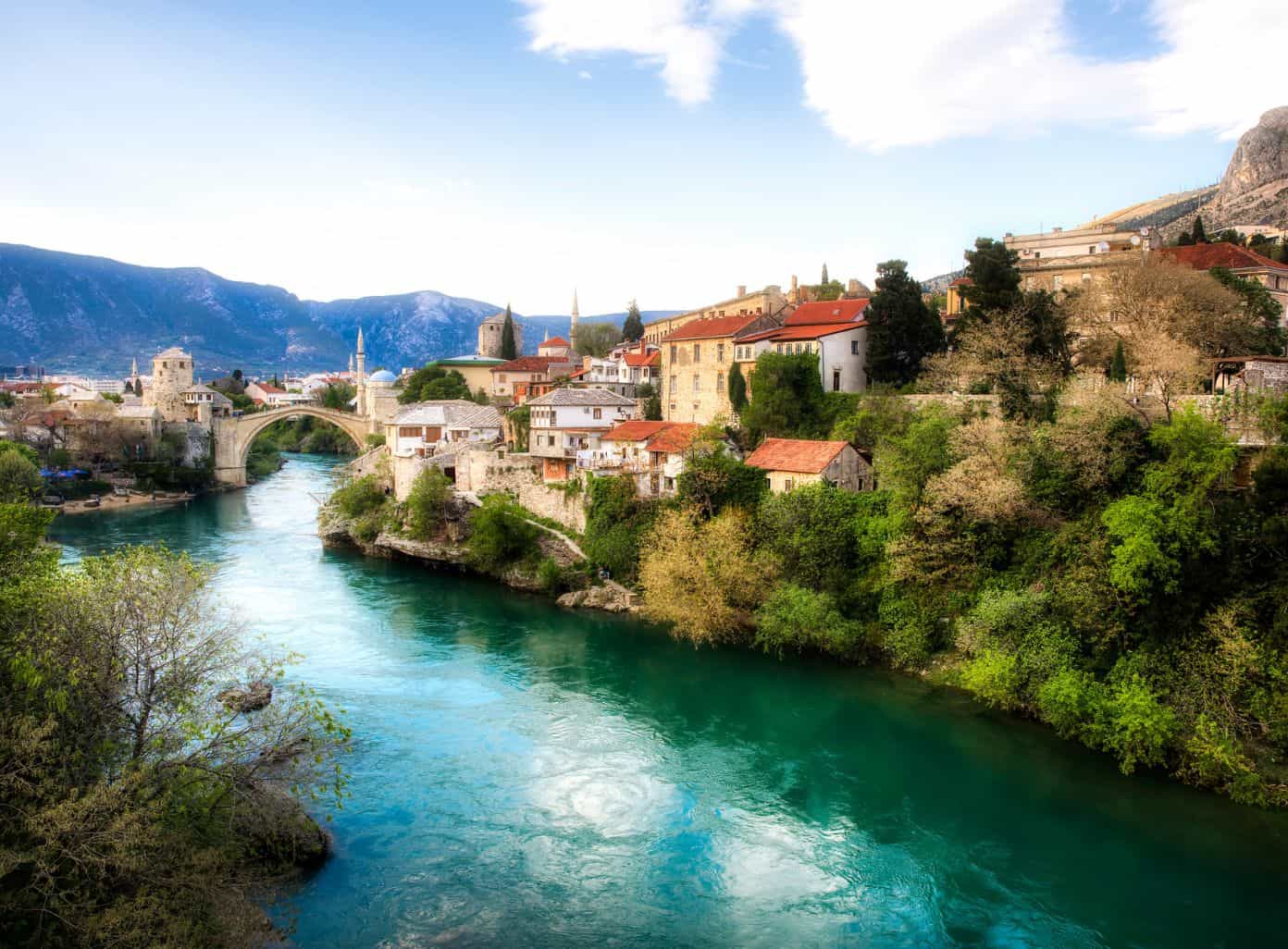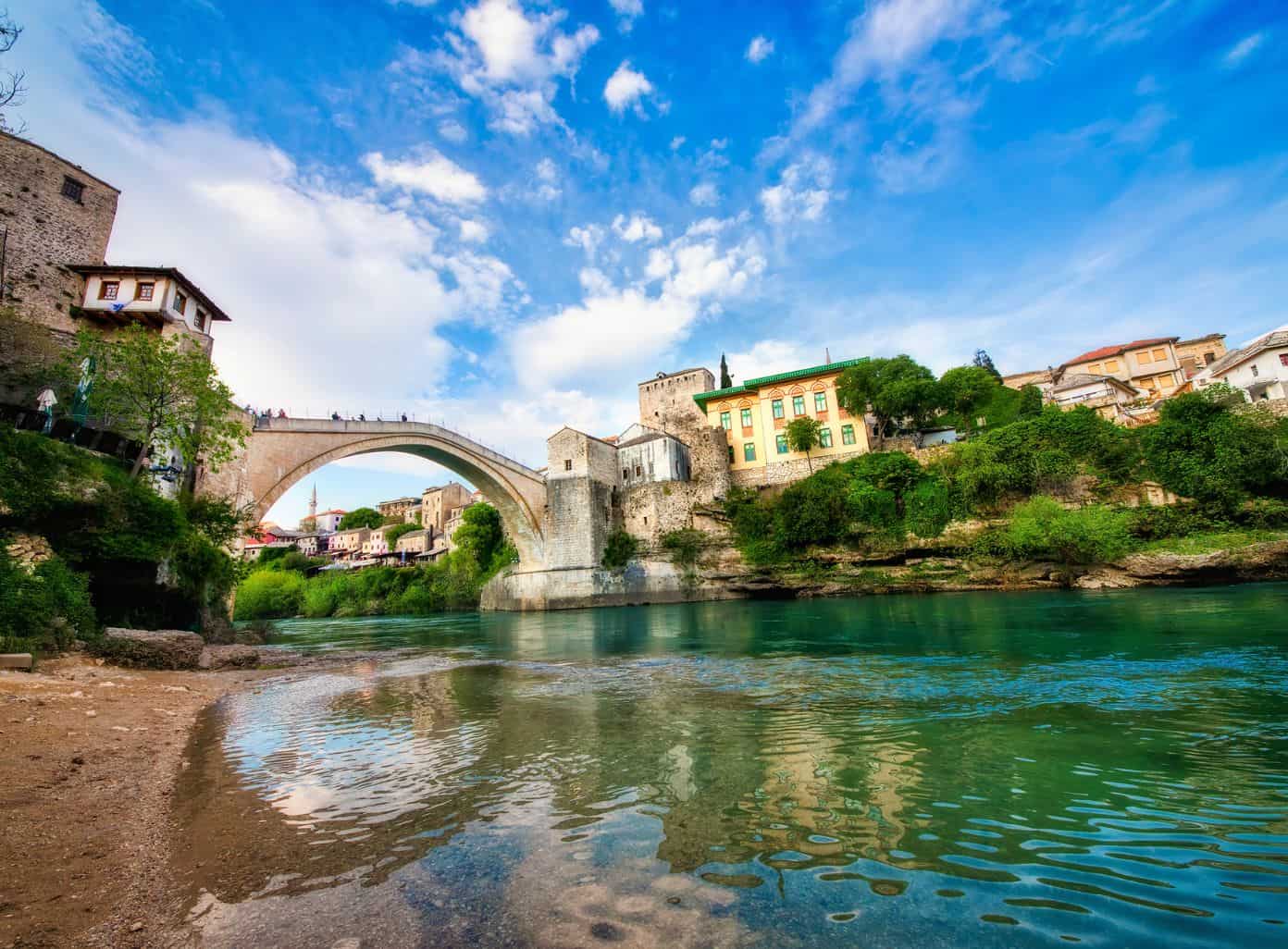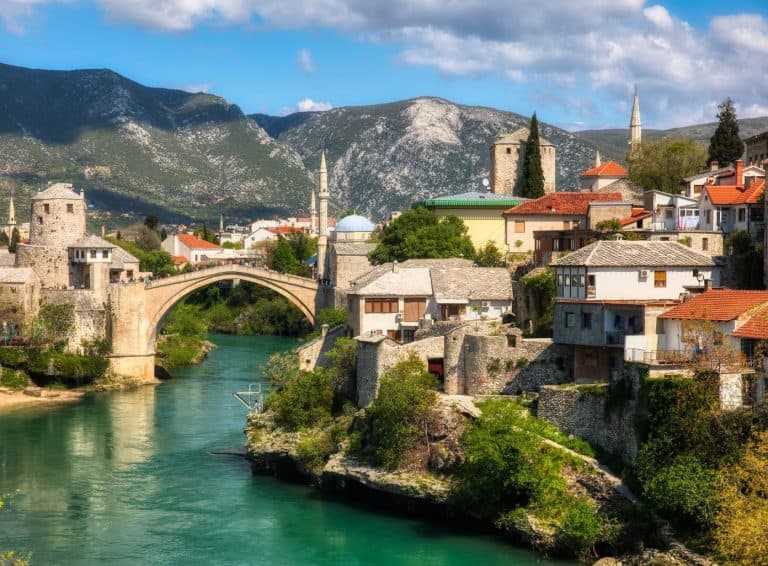The Stari Most Bridge, located in the enchanting city of Mostar, Bosnia and Herzegovina, is a remarkable structure that holds a significant place in history. This article explores the bridge’s rich heritage, its architectural marvels, the devastating events that led to its destruction, and its present-day importance as a tourist attraction and symbol of unity.
Introduction to the Stari Most Bridge

Standing gracefully over the emerald Neretva River, the Stari Most Bridge is a mesmerizing sight that captures the hearts of all who visit Mostar. Its name translates to “Old Bridge,” and as the name suggests, it is a testament to the city’s glorious past. With an age that surpasses four centuries, this bridge has witnessed numerous historical events and embodies the spirit of the city.
The Bridge’s Location and Basic Features
Nestled in the heart of Mostar’s old town, the Stari Most Bridge connects the two halves of the city, East and West. Spanning across a length of 29 meters, the bridge mesmerizes visitors with its elegant arch, reaching a height of 24 meters. Built using local limestone, the bridge’s pale stones shimmer under the warm sun, adding to its grandeur.
Two main pillars support the arch, which is ingeniously designed to withstand the forces of nature. Balustrades line the sides of the bridge, offering pedestrians both safety and a magnificent view of the surrounding landscapes.
Why is Stari Most Bridge Iconic?
Stari Most Bridge’s iconic status stems from various factors. Firstly, its architectural brilliance, blending Ottoman and European elements, reflects the cultural and historical fusion of Mostar. Secondly, its historical significance, surviving the test of time and adversity, makes it a symbol of resilience and unity.
The Historical Significance of Stari Most Bridge

The Bridge’s Construction and Original Purpose
The construction of Stari Most Bridge began in 1557 under the direction of the renowned Ottoman architect Mimar Hayruddin. It served as a vital connection between the diverse communities on either side of the river, facilitating trade and cultural exchange. Moreover, the bridge’s location was strategically chosen to ensure smooth passage for travelers and merchants along the ancient caravan routes.
In addition to its practical functions, the bridge also acted as a social and cultural hub, hosting various events, including exhibitions, performances, and religious ceremonies. It fostered a sense of communal belonging among the inhabitants of Mostar.
The Role of the Bridge in Local and National History
Over the centuries, Stari Most Bridge played a pivotal role in the region’s development and history. It witnessed the rise and fall of empires, the blending of cultures, and the turbulence of war. The bridge symbolized the unity and diversity of Mostar’s residents, as people from various backgrounds gathered there to celebrate, mourn, and discuss important matters.
Its presence also inspired artists and writers, who immortalized the bridge in their works. Its image adorned postcards, stamps, and literature, becoming an enduring symbol of Mostar’s beauty and charm.
The Architecture of Stari Most Bridge
Unique Architectural Features of the Bridge
Stari Most Bridge’s architectural design reflects the expertise of its builders. The use of local stone, meticulously carved and fitted together, lends the bridge its distinctive appearance. The arch, with its gentle curve, embodies the harmonious blend of mathematics and aesthetics.
The stone steps leading to the arch add an extra touch of elegance, inviting visitors to ascend and relish the panoramic views. The balustrades, adorned with intricate patterns, showcase the craftsmanship and attention to detail of the artisans.
The Influence of Ottoman Architecture
As an emblem of Ottoman architecture, Stari Most Bridge borrowed elements from the Islamic architectural tradition. The bridge’s arch, resembling a horseshoe, reflects the characteristic arches found in Ottoman structures. The intricate geometric patterns engraved on the balustrades and the symmetry of the bridge pay homage to Islamic art and design.
The Destruction and Rebuilding of Stari Most Bridge
The Bridge During the Bosnian War
The Bosnian War (1992-1995) marked a dark period in the history of Stari Most Bridge. The city of Mostar became a battleground, and the bridge suffered severe damage during the conflict. On November 9, 1993, the bridge collapsed into the river under intense shelling, leaving behind a void in the hearts of the people.
The International Effort to Rebuild Stari Most
The destruction of Stari Most Bridge brought forth an international outcry for its restoration. Recognizing its historical and cultural significance, UNESCO led the initiative, rallying countries, organizations, and individuals to contribute to the rebuilding project. Using traditional methods and drawing upon historical records, the bridge was reconstructed from the original stones, preserving its essence and ensuring historical continuity.
Stari Most Bridge Today
The Bridge as a Tourist Attraction
Today, Stari Most Bridge stands proudly as a prominent tourist attraction, drawing visitors from around the world. Its architectural splendor, intertwined with the city’s captivating ambiance, creates an enchanting experience. Tourists can stroll across the bridge, enjoying breathtaking views of the river and surrounding medieval buildings. The bridge also serves as an excellent vantage point for observing the thrilling tradition of bridge diving, a daring spectacle where local divers plunge into the icy waters of the Neretva River.
The Bridge’s Role in Modern Mostar
Beyond its allure for tourists, Stari Most Bridge holds immense symbolism in the modern context of Mostar. It serves as a reminder of the power of unity and reconciliation, as the city continues to heal from the scars of the past. The bridge acts as a meeting place for locals and tourists alike, fostering dialogue and understanding. It stands as a testament to the resilience of the human spirit and the ability to rebuild and overcome even the most devastating of circumstances.
As the sun sets over the Stari Most Bridge, casting a golden glow upon its weathered stones, one cannot help but feel a sense of awe and admiration for this historical landmark. It represents much more than a mere crossing over the river; it represents the history, culture, and spirit of Mostar itself. The Stari Most Bridge, an embodiment of human ingenuity and resilience, will continue to stand for generations to come, leaving an indelible mark on all who have the privilege of beholding its magnificence.


